Dialogue: Manufacturing is Still a People Business

Rockwell Automation Chairman and CEO Blake Moret sees a highly automated future for plants and factories, but one in which simplification and empowering people with data-driven insights will be key.
In 1903, two years after Lynde Bradley invented the compression rheostat to control the speed of electric motors, he and Dr. Stanton Allen formed the Compression Rheostat Company. In 1909, the company was re-incorporated as the Allen-Bradley Company.
Decades of innovation followed, including the first solenoid starter with a single moving part, the incorporation of Allen-Bradley resistors in early mainframe computers, and the use of ferrite magnets in color televisions and computer memory cores.
In 1970, Allen-Bradley pioneered the programmable logic controller, and nine years later introduced Data Highway, the first plant floor network that replaced miles of wiring. In 1985, Rockwell International acquired Allen-Bradley, and in 2001 the company was officially renamed Rockwell Automation.
In February of this year, Rockwell Chairman and CEO Blake Moret sat down with the MLJ’s David R. Brousell to discuss industry trends, including the prospect of autonomous factory operations, the use of AI, and how advanced technologies may change the roles of manufacturing workers and leaders. MLC members recently toured Rockwell’s factory in Cleveland, Ohio, for a first-hand look at how Rockwell is running one of its own factories today (read the plant tour report).
Below are excerpts from the interview, which has been condensed for length and clarity.
Q: MLC research into the effects of the pandemic clearly showed an acceleration of the adoption of digital and automation. Are you seeing that acceleration continuing or has it leveled off or entered a new phase?
A: I think that the acceleration has continued. During the pandemic, people had to innovate because you couldn’t have the same kind of mobility, the same number of people from lots of different companies collaborating. Applications like remote monitoring, the need for cybersecurity modeling, using digital twins — all of these concepts got turbocharged during the pandemic, and they continued as people needed to continue to innovate during subsequent supply chain shortages. So I think those things that people saw could be done and could be done at scale have continued.
The urgency that was created during the pandemic has really persisted. There is no turning back now. Everybody was hunkered down and thinking about how they could gain share and do things differently. And so that determination and that commitment has continued.
Q: You have been talking for some time about Rockwell’s mission as “creating the future of industrial operations”. At your November 8th Investor Conference in Boston, you said, regarding automation, that “people need to have superpowers” now in plants and factories. Talk a little bit about what that means, what your vision of a factory or plant is going into by 2030.
A: First of all, I think there will still be people in manufacturing plants. There are examples, of course, of lights-out factories, I don’t think that’s the end goal for the vast majority of manufacturers and their processes. Rather, it’s taking the people and freeing them up for the things that people are uniquely qualified to do and giving them data-driven insights so that they can use their decision-making powers to add innovation to processes but doing it working closely with the technology.
Q: I want to dig a little deeper into that question because the research we’ve been doing at MLC clearly shows that autonomous operations are on radar screens. In our Smart Factory Survey, the results of which we published in January. 48% of the respondents said that they are anticipating some degree of autonomous operations by 2030, with 12% of that group saying they’re expecting fully autonomous. Rockwell has been emphasizing autonomous production logistics. Do you think autonomous operations, although they could be technically feasible, are desirable?
A: I think we’re already seeing the benefits. If you think of traditional automation, that’s a portion of the autonomous operations equation in production, design, and control. That’s traditional automation — sensing, thinking, acting, taking inputs, interpreting them, and then changing the state of the final-mile devices. Add to that new forms of motion control or autonomous mobile robots, which is a big bet that Rockwell placed in the last few months, and you have a holistic view of what’s happening on the factory floor, along with people, of course. We’re already seeing companies across multiple industries making investments there, whether it’s the automotive industry, food and beverage, consumer packaged goods, life sciences, or in pharmaceuticals. All of them are seeing the opportunities in terms of the logistics of bringing material components to align and then taking finished goods away, moving it either to the loading dock or the warehouse. And above all of that, it’s the edge and the cloud information solutions to take all that data, bring it together, and give insights back to the people.
“I think AI has the opportunity to play a bigger and bigger role primarily to simplify the business of automation.”
Q: You mentioned the robotics side. Do you think the process side of the industry is further ahead compared to discrete?
A: I think that certain vertical industries have differing amounts of automation intensity. You can’t build a car, for instance, in discrete manufacturing without a high degree of automation, of programable controllers, robots and so on. In process, certainly control systems are managing the process loops, the integral safety as a part of that. When you think of a refinery or an ethylene cracker, there’s a certain amount of automation as well. Both have common threads. So there’s a need for open data exchange because there’s lots of different manufacturers represented on the floor, lots of different vintages of those products. And the ability to bring all that data together is a common need on both ends of the automation spectrum of applications.
But, there’s some basic common threads across all of those. And all of those industries see a need to simplify these processes because they all have a common need to be able to engage the broadest talent pool. And, of course, that talent pool in many cases has not more than a high school education.
And so the ability to provide technology that they’re comfortable interacting with and then the ability to grow during their careers is vitally important.
Q: Some people are saying that convergence is leading to the idea of data ecosystems. Do you think the ecosystem concept is something that’s going to actually take hold or are there too many issues around culture, around IP protection that are going to slow this down?
A: I think ecosystems are absolutely crucial and with industry-focused expertise represented within those ecosystems. If we talk about the technology of industrial operations or autonomous operations, there’s the expertise piece of it, the manufacturing lifecycle management that comes from people who are comfortable with these applications. And then there’s the ecosystem, because no one company is going to have all the answers.
When you think about the percentage that Scope 3 emissions play, it’s even more important to be able to assemble those industry-specific ecosystems. This may be the next frontier for us.
Q: You had a conversation at your recent Automation Fair with Microsoft’s Judson Althoff where he said “AI transformation succeeds digital transformation”. Do you agree with this idea? How significant a role do you think AI is going to have in manufacturers’ future operations and in how they think about their own competitiveness?
A: I think it’s a big deal. First, AI and its application in machine learning has been around for a while. A lot of the current press is around GenAI and ChatGPT-type language models. But the opportunity for self-learning, self-optimizing control systems has been around for a while and it’s having greater and greater impact.
In manufacturing, the ability to take difficult challenges in terms of process control, being able to look at areas where you relied in your plants on people with 30 and 40 years of experience who are now retiring, I think AI has the opportunity to play a bigger and bigger role there. We see it as primarily an opportunity to simplify the business of automation for our customers and for them to be able to engage a larger pool of workers as well as to reduce errors in standard, existing workflows.
There’s certainly a whole lot of internal processes in our own operations and in our own systems that can benefit from it. But I think we’re focusing first on what it can do for our customers.
“I do think that complexity is the primary deterrent to more rapid incorporation of technology in automation ….”
Q: What advice would you give to companies that are obviously aware of what’s going on but may not have stuck their big toe in the AI waters yet? How should they think about strategizing around AI and prioritizing investments?
A: Start with a well understood, finite problem that they have in their operations today. This is something that’s real, where they know that they’re going to get a big financial and/or time benefit by addressing it. Apply the resources on that problem, build the right team of experts, including everybody from the plant. People who are going to need to live with the incorporation of the new technology, to outside experts who can work well with their internal team. Get the benefits of that one challenge, and then expand it from there. And make sure the data is good.
Q: I was really thrilled when I heard you say simplification is going to sort out the winners and losers of this business in the next ten years because MLC has been focusing on the complexity issue. We’re very concerned that the more complex manufacturing companies get technologically, the harder it is to be resilient. How do manufacturers get the full benefits of often innovative, proprietary technologies that are coming out while at the same time avoiding the complexity that could lead to real daunting integration problems?
A: I think the simplification pertains to not just the technology, but the business model and the ecosystem as well. I do think that complexity is the primary deterrent to more rapid incorporation of technology in automation — whether it’s the way the pieces come together, the way that it’s required to maintain these systems, upgrade them, commission them, all throughout the lifecycle, and then the business models for being able to bring in the right technology and ensure that you’re getting the right support for it as well.
I think all of those aspects together point to the importance of simplification in these processes. That’s going to help us in the automation business to be able to see more rapid adoption of new technology.
Q: But simplification based on a rational architecture?
A: Yes. You do have to have that architectural component. Otherwise, you’ve got multiple architectures going on. Everybody gets into this journey at a different phase. They’re at a different point in time, and nobody is going to be able to adopt all the right technology, train the people in all the right areas, and to be able to say two or three or four years from now, we’re done.
It’s got to be a learning organization and, as you said, it requires an architecture that’s capable of ingesting new innovation as well. There’s a lot of new, innovative technologies coming at companies — whether it’s AR/VR, blockchain, or any of the technologies we associate with the emerging industrial metaverse set of technologies.
“Leaders need to have the ability to explain the why, to be able to recruit others to their cause at all levels of the organization.”
One of the biggest issues is just keeping up with the technology. But start with a problem that you understand. Don’t just go on a fishing trip. Start with something real. Solve a business problem.
Q: Thinking about the people who will occupy positions of leadership in the digital economy in the years ahead, what do you believe will be the most important characteristics that will define successful leadership of manufacturing companies as they become digital companies?
A: Well, let me start with what I don’t think is changing. I think that the leaders for today and tomorrow need to have a certain amount of experience, paying their dues with understanding what their processes are actually expected to accomplish. I don’t think there’s a magic formula. Even with all this new technology, leaders need to understand how things are being done and what the end goal is of their processes.
That being said, being comfortable dealing with volatility is key. What we have seen over the last few years are things that were never modeled before. Nobody did tabletop exercises to prepare for a lot of the things we’ve had to deal with. And so, you have to have a certain number of people who have the wiring to be, if not comfortable, at least understanding that this is a part of the job.
I think the other piece, as people managers, these leaders need to have the ability to explain the why, to be able to recruit others to their cause at all levels of the organization. That’s important. At the end of the day, it’s still a people business. M

FACT FILE: Rockwell Automation, Inc.
Location: Headquarters in Milwaukee, Wisconsin
Business Sector: Industrial automation and digital transformation
Revenues: $9 billion
Employees: 29,000
More than 100 countries
EXECUTIVE PROFILE: Blake Moret
Titles: Chairman and Chief Executive Officer, Rockwell Automation, Inc., and Chairman of the Rockwell Automation Charitable Corporation
Education: Bachelor’s degree in mechanical engineering, Georgia Tech
Industry Presence: Vice Chair, National Association of Manufacturers; member, Wisconsin Governor’s Council on Workforce Investment; co-chair of the World Economic Forum’s Advanced Manufacturing Community of CEOs; board member of the Business Roundtable; and board member of the Advanced Regenerative Medicine Institute (ARMI), Georgia Tech Advisory Board, FIRST Robotics, the United Way of Greater Milwaukee and Waukesha, and the Boys and Girls Club of Greater Milwaukee.
About the author:

David R. Brousell is Founder, Vice President, and Executive Director at the NAM’s Manufacturing Leadership Council.
Using Predictive Analytics to Improve Product Quality and Performance

Case study in how Nexteer is deploying predictive analytics to improve critical manufacturing processes, optimize production and reduce costs.

TAKEAWAYS:
● Collecting and analyzing data from sensors, machine logs and other sources can identify patterns and anomalies, enabling engineers to take proactive measures that prevent downtime, optimize production and reduce costs
● Predictive analytics can enhance communication and collaboration throughout a manufacturing operation.
● Harnessing the power of data and advanced analytics is key to Industry 4.0-level digital transformation.
Automotive steering and driveline product manufacturer Nexteer wanted to improve its critical manufacturing processes as part of its Industry 4.0 journey. As one step on that journey, the manufacturer turned to predictive analytics technology to improve the functional performance for its motion control systems and reduce the reject rate for end-of-line function testing. This project was selected as a finalist for the 2023 Manufacturing Leadership Award in the Engineering and Production Technology category.
The objective of the project, which kicked off in January 2020, was to develop and implement predictive analytics tools such as Big Data and machine learning technology to identify features that have an influence on end-of-line function testing. This is a complicated task, since a typical assembly can include thousands of features, including component dimensions, assembly parameters, and process parameters. One key aspect of the project was to install IIOT-based real-time vibration and force monitoring on critical components of its manufacturing process, with the goal of moving problem solving from a reactive to a proactive mode.
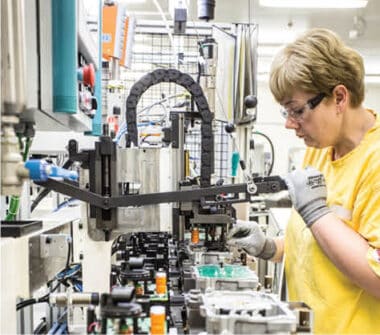
“By generating insights from data, the company was able to detect anomalies sooner, which led to … improved performance and reduced rejection rates.”
The result: By generating insights from data, the company was able to detect anomalies sooner, which led to earlier detection of machine issues, as well as improved performance and reduced rejection rates.
“As Nexteer advances its pursuit of increased business efficiency, it has recognized the limitations inherent in a reactive approach to problem-solving,” said Kevin Douglas, Executive Director, Global Manufacturing Engineering with Nexteer. “The necessity of transitioning to a proactive strategy is clear. This project shows Nexteer’s commitment towards a fully proactive future using Industry 4.0 transformation.”
Two Cases in Point
Nexteer made use of several technologies to identify the patterns and anomalies that will help engineers identify potential problems or inefficiencies in the production process. Here are two of the projects that used predictive analytics to improve performance and cost-effectiveness:
Project 1: Reduce the reject rates for end-of-line function tests
Solution: Machine learning algorithms were developed to identify factors that contribute to the end-of-line function tests. A machine learning dashboard incorporating a non-linear regression model predicted, with a 95% confidence interval, that modifications in these pivotal factors would substantially reduce the reject rates.
Result: Implementation of these data-driven recommendations led to a significant decrease in the reject rate, showcasing the efficacy of integrating machine learning techniques in optimizing production quality.
Project 2: Detect and diagnose machine problems causing quality issues with component manufacturing
Solution: The company designed a real-time system to monitor vibration and cutting forces during machining operations of critical components. The system was comprised of force and vibration sensors, an industrial computer running specialized software, and a connection to a secure business network for the transfer of vibration and force data to a database. They also developed web-based routines to analyze the vibration and force data, ensuring a comprehensive understanding of the machinery’s performance.
Result: Being able to quickly detect and diagnose machine problems before they resulted in increased reject rates resulted in lower operational costs and also enabled proactive machine maintenance.
Improving Crucial Business Metrics
One of the goals of the project was to improve first-time quality by reducing scrap and rework, as well as increasing productivity in high-growth markets. The superior performance of the product that resulted led to increased customer satisfaction and an increase in market share. Being able to collect and analyze data from IoT sensors and the company’s database, among other sources, provided valuable insights into the production processes and equipment performance, allowing for early detection of equipment failure or inefficiencies. This enabled engineers to take proactive measures to reduce downtime and optimize production.
In addition, having data readily available to plant floor personnel empowered operators, maintenance staff, and other production employees to quickly and effectively resolve problems before they became major issues — and improved collaboration and communication throughout the organization.
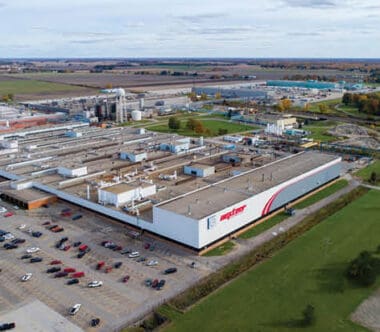
“Having data readily available to plant floor personnel empowered operators, maintenance staff, and other production employees to quickly and effectively resolve problems before they became major issues.”
Both the advanced analytics and IIOT technologies developed during the project now are being implemented in other critical manufacturing processes.
Steven Harris, Nexteer Vice President, Global Engineering, said, “In our journey towards Industry 4.0, Nexteer is harnessing the power of predictive analytics and Big Data, fundamentally transforming our manufacturing processes. Our goal was clear: enhance the functional performance of our systems and evolve from reactive to proactive problem-solving. This initiative has not only achieved our initial goals but also catalyzed productivity gains in key growth sectors. This success demonstrates our commitment to innovation and continuous improvement, setting a new standard in the automotive industry. Through this project, we are moving confidently forward, embodying the true spirit of Industry 4.0.” M

COMPANY FACT FILE
Name: Nexteer Automotive
Sector: Automotive
HQ location: Auburn Hills, MI
Revenues: $1 billion to $9.9 billion
Employees: 5,000 plus Employees
Web url: www.nexteer.com

Sue Pelletier is a contributing editor with the Manufacturing Leadership Journal.

Pravin Khurana, Ph.D. is Principal Manufacturing Engineer at Nexteer Automotive. He is responsible for leading IIOT and Advanced Data Analytics projects at Nexteer.
Digital Transformation Is Foundational for M4.0 Maturity

Manufacturers should prioritize data-driven decision-making and IT infrastructure.

TAKEAWAYS:
● Seventy-seven percent of respondents to an RSM survey said they plan to increase their information technology budgets in 2024.
● Middle-market organizations may have some catching up to do when it comes to digital transformation.
● Strategic investment in advanced technologies should be a priority.
Embracing digital transformation is more critical than ever for manufacturers, especially those in the middle market. That’s because midsize companies across the economy are poised to invest more in technologies central to digital transformation, according to data from the 2023 RSM US MMBI Digital Transformation Special Report, an RSM US Middle Market Business Index survey. For the survey, the Harris Poll interviewed 404 middle-market senior executives from a broad range of industries and sectors in April 2023.1 More than three-quarters (77 percent) of all MMBI survey respondents said they plan to increase their information technology (IT) budgets in 2024. Similarly, 74 percent of respondents indicated that digital transformation was the most important area or among the most important areas of investment for their companies.
Even with these priorities though, companies are not always clear about how to achieve their digital transformation goals, the survey found. According to the report, “Over half (52%) of all respondents have a clear and agreed-upon digital strategy that addresses their IT and digital transformation goals. But while one-third (33%) of all respondents have plenty of digital activities underway, they have not formalized their approach into a digital strategy.”
“Embracing digital transformation is more critical than ever for manufacturers, especially those in the middle market.”
For manufacturers, important factors behind a successful digital strategy include how organizations use data to drive decision-making, how they adopt advanced technologies in their supply chains, and how they prioritize enhancements that will make their IT infrastructure more resilient.
We examine some of the most important digital transformation considerations for manufacturers zeroing in on their journey toward M4.0 maturity.
Building a Digital Strategy
Manufacturers need to have technologies and processes in place that enable them to harness, filter, and analyze data with relative ease. This is foundational to digital transformation efforts, especially as factories become more connected with the use of Internet of Things (IoT)-enabled devices, sensors, and other machines. Governance, system architecture, and analytics are the three most critical data prongs for developing a strong digital strategy.
Data analytics in particular is central to helping manufacturers adapt to supply and demand changes, shifting geopolitical risks or myriad other ebbs and flows in the market. Analyzing sales, production, and supplier data can shed light on how customer preferences are changing, identify product backlogs, help with quality assurance, and more.
As noted in the RSM article “Modern manufacturing: Embracing the digital future,”2 “In truly digital factories, real-time metrics make adjusting to supply chain disruptions easier, connected devices make operations more seamless, and a variety of advanced technologies make scenario modeling more accurate.”
Manufacturers can tap into their data to develop comprehensive inventory dashboards, for instance, that can pull real-time information into one place. That can make it easier for companies to
- Monitor inventory, in terms of both quality and quantity;
- Adapt distribution and warehouse capacity as needed; and
- Forecast demand trends.
Artificial intelligence (AI) also offers many promising features like data analysis and financial forecasting to enhance efficiency, streamline processes, and improve decision-making.
At the time of the MMBI survey in April 2023, “Fewer than half of executives polled (44%) said they or someone they worked with had personal experience using ChatGPT or a similar generative AI platform,” Also noted in the report, “Broader company adoption was similar: Just 28% said their business was currently using AI and machine learning, and another 20% said they were planning on using it within the next year. Since that time, it would appear the adoption of this new technology has quickly risen, with numerous polls, news releases and public company earnings transcripts citing the ubiquity of AI.”
“Governance, system architecture, and analytics are the three most critical data prongs for developing a strong digital strategy.”
For many companies, though, digital transformation doesn’t mean upgrading platforms or using new technologies like generative AI. According to the MMBI report, “Many organizations are simply focused on securing their assets and strengthening their IT infrastructure.” In addition, “An overwhelming 88% of all respondents said they currently employ cybersecurity or data security in their businesses or plan to do so within the next 12 months, making it the most popular choice in the survey. Increased concern over cybersecurity was the top motivation respondents gave (65%) for changing their IT budgets.”
Manufacturers need to make sure their IT infrastructure is scalable and flexible for future growth. They also need to enhance it as needed to ensure compatibility with Industry 4.0 technologies that are becoming more common on factory floors and throughout operations.
Questions to Frame the Path Forward
Looking to the future, manufacturing leadership teams may find it useful to address these four questions to assess where they are and identify their ideal future state when it comes to digital transformation efforts:
- How are you evaluating your existing IT infrastructure and upgrades it may need to be able to support advanced technologies?
- Where might there be opportunities for your business to analyze data that are already at your fingertips?
- How are you making sure your leadership team is aligned on digital transformation priorities and implications across the organization?
- How might outsourcing some of your IT services help your broader digital transformation efforts?
If it feels like there is an overwhelming amount of work ahead for your business, know that it’s a common position. “Just over a third (38%) of respondents say they have substantially achieved their digital transformation goals,” the MMBI report said. “However, a slightly larger percentage (41%) say they are way off from achieving their digital transformation goals.”
Wherever your organization is on its digital maturity journey, it’s important not to lose sight of the fact that digital transformation will never truly be “finished.” Instead, consider it a constant evolution. M
Footnotes:
[1] Information from the RSM US Middle Market Business Index survey was originally published on RSMUS.com.
[2] This paragraph was originally published in the RSM article “Modern manufacturing: Embracing the digital future.”
About the authors:

Kendra Blacksher is a partner and industrials senior analyst at RSM US LLP.

Katie Landy is a principal and industrials senior analyst at RSM US LLP.
Ascending from Pilots to Manufacturing 4.0 Maturity

Tips for selecting, optimizing, and scaling digitalization initiatives across the enterprise

TAKEAWAYS:
● Manufacturers need to carefully evaluate compatibility, scalability, and trustworthiness when selecting digital solutions.
● Prioritizing effective digital transformation investments and executive support is crucial in this evolving landscape.
● Establishing a unified strategy owner can increase successful implementation and progress across the enterprise.
Personnel at all levels of manufacturing organizations are being tasked with “getting on board with the future,” often with little direction on what that really means and without a digital transformation leader providing a strategy or roadmap. As a result, lofty digitalization goals that begin as small-scale pilots may stall when gaps in understanding or planning exist, even if they yield great returns in isolation.
Aspirations for widespread Manufacturing 4.0 adoption are best served when there is clarity on where, when, and how to make technology investments as well as the larger implications on implementation, scalability, organizational change, and culture change. It is especially important in today’s environment of fast-moving and dynamically evolving innovations that are different from anything historically available to the industry.
Navigating Countless Technology Options
Myriad available software and technology solutions, at varying levels of maturity, offer the promise of advancing industrial digitalization goals. Informed consideration of whether a proposed technology initiative will “play nice” with another, deliver value, and scale adequately is necessary when choosing to make technology investments to optimize production and manufacturing performance.
Complicating matters are the newness of the digitalization market and the prevalence of:
- Niche technology providers: A multitude of niche players are still trying to determine where they fit in the larger market. This increases the burden on manufacturers trying to define what they need, who offers the solution, and how they can make it work with the technologies and digital infrastructure already in place.
- Venture capital startups: Very small startup companies often launch small-scale projects knowing they cannot, on their own, scale their business to develop at the rate their customers require. With a professional website, logo, and marketing material, they may appear to be a big player when they actually have few employees and customers. This does not make them irrelevant as they may have a solid vision of a wonderful product, but behind the scenes they are courting established solution providers for help penetrating the market, and some are fundamentally hoping to get bought out.
- Marketing ambiguity: Many digital solution providers present a general idea of the space they are in and the markets they serve, but their web pages and literature are not especially clear on what exactly they do and the solutions they provide. There may be talk of an ability to streamline certain processes and deliver some level or timing of ROI, and maybe a vague case study with a customer example, but there is little clarity on what the application actually does or how it works.
- Trust issues: For manufacturers and technology providers alike, it is difficult to know who you are doing business with these days unless you are dealing with an established, reputable company. There are empty promises when planned or in-development capabilities on a product roadmap never come to fruition. There are companies seeking demonstrations purely to validate their messaging or decision making rather than make commitments. And with very small startups, you do not really know what you are going to get or whether the company will be around for the long term.
Who Owns the Digital Transformation Strategy?
With all the complexities at stake, there remains a severe shortage of people who really understand how the puzzle pieces of a digital transformation strategy can fit together. Manufacturers rarely have a holistic internal roadmap or a single strategy owner who understands both information technology (IT) and operational technology (OT).
Granted, it is very common to see CTOs, CIOs, and IT organizations that are very capable and mature from an architecture standpoint. They have tried-and-true methodologies for ensuring their business infrastructure is technologically advanced and on the latest cloud-based platforms. And they have systems integrators or technology specialists providing solid insights related to IT enablement.
“Many manufacturers that have piloted limited initiatives are unsure how to measure success, and how to scale and integrate the solutions to execute on a daily basis.”
The gap in vision and execution, however, is at the factory floor level. There is not a lot of well-tenured expertise in how all the IT and OT pieces fit together within the rank and file of manufacturers, nor in the industry at large.
For instance, every original equipment manufacturer (OEM) has some sort of connected platform. There are third-party Industrial Internet of Things (IIoT) providers offering strategic solutions, such as sensor-based machine health monitoring and analytics from Advanced Technology Services (ATS). And there are different supervisory control and data acquisition (SCADA) platforms, data historians, and other enterprise resource planning (ERP) and enterprise asset management (EAM/CMMS) plugins. Whether and how these solutions are connected will impact asset reliability and operational performance.
Consequences In Change Management
When faced with an overwhelming disconnect in knowledge and lack of leadership on the strategy, manufacturers have difficulty seeing the big-picture vision and do not know how to make all the transformational technologies and processes work harmoniously. Consequently, many manufacturers that have piloted limited initiatives are unsure how to measure success, and how to scale and integrate the solutions to execute on a daily basis. Despite the hints of potential value, the lost progress and addition of manual work contribute to resistance to change.
How to Right the Ship
Since the root of the challenge is the lack of tenured understanding when it comes to digital transformation technology, it is critically important to have someone at an enterprise level leading the strategy who:
- understands the underlying architecture for the OT side of the business,
- knows how M4.0 digitalization and the IIoT fit into the overall operation,
- is open to new and different offerings and non-traditional ways of doing business,
- can decipher and assess prospective platforms and technologies, including smaller, newly built, and potentially insecure solutions,
- can articulate to stakeholders what the solution does, why it is needed, how it interrelates with existing solutions, and where it falls on the company’s roadmap to digital transformation, and
- is capable of merging the IT and OT technology pieces while ensuring the security protocols are what they need to be.
This individual and their assessment process for what is deployed to the factory floor is crucial to advancing beyond discrete pilot tests to M4.0 maturity. They can prioritize scalable, effective digital transformation investments by establishing where the real opportunities lie, developing a business case, understanding the budget and the return expected from the solution, and determining which vendor(s) can deliver on the goal.
Fortunately, gaining executive support is less of a challenge today. Not long ago, the earliest drivers and adopters of advanced technologies were often forward-thinking engineers. That has since shifted with the C-suite now focusing on digital transformation as a competitive advantage. Increasingly, technology enhancements are pre-approved, in the budget, and part of the plan. What may be lacking is executive direction unless there is someone bridging the knowledge gap between the factory floor and the executive office.
How Partners Can Help
When expertise is lacking in house, being open to partnering with strategic technology and service providers can turn the tide in digital transformation success. Instead of making a “build versus buy” decision, a bit of both is needed. Ultimately, any technology enhancements must live within an infrastructure that suits your enterprise integration, security, and data attribute requirements.
Expert technology and service providers can help facilitate digital transformation planning and close knowledge gaps. ATS does this by bringing their solutioning specialists to even the earliest customer engagements. Being on the front line allows them to better extract customer requirements, articulate new solutions that will work with existing solutions, anticipate future needs, and prioritize the integration of capabilities from a product management standpoint. They can also coach customers through what the potential could be and how you might work together.
“The earliest drivers of advanced technologies were often forward-thinking engineers. That has since shifted with the C-suite now focusing on digital transformation.”
Partnering can also lead to the service provider extending the value of existing customer investments. Incorporating a customer’s small-scale successes into the provider’s larger digitalization solution makes them scalable across the enterprise.
An example is predictive maintenance, which is the proven strategy for improving uptime by detecting and correcting degrading asset conditions before failure occurs. In one use case, ATS helped protect a packaging manufacturer’s plant maintenance team from being overwhelmed by massive and growing volumes of data by automating the collection of machine sensor data and centralizing it for expert analysis and prescriptive recommendations. This allowed the manufacturer to meet reliability and performance objectives more efficiently and effectively.
Finally, it is important to remember that there is no magic bullet in digital transformation. In this example, automating data gathering and analysis does not replace maintenance best practices or standard work. If nobody acknowledges the alert of impending failure or executes the recommended actions, the asset will still fail. Make sure that processes for planning and scheduling corrective actions and closing the loop afterward continue to be followed. M
About the Author:

Micah Statler is Director of Industrial Technologies at Advanced Technology Services.
Revisiting M4.0 Maturity at a Critical Juncture in Innovation

Fostering digital maturity means building a strategy where tech investments are made to reach specific goals.

TAKEAWAYS:
● While many manufacturers associate digital maturity with investing in AI, that investment alone is not a strategy.
● Manufacturers must ask themselves a series of key questions about their desired future state, current shortcomings, and possible challenges.
● Continuous progress means supporting change management and evolving strategies to adapt to shifting needs and priorities.
What is Industry 4.0 Maturity?
Innovation is in manufacturers’ DNA. Technological advancements have enabled the manufacturing industry to increase the speed and complexity of production and remain a primary driver of U.S. economic growth over centuries of change. The printing press enabled the mass production of books. Centuries later, robotic arms allowed manufacturers to assemble thousands of automobiles to exact specifications. Today, advancements in AI are starting to enable manufacturers to engineer better products, improve their decision-making capabilities, glean deeper insights, and automate tasks beyond what was possible before.
Industry 4.0 technologies can help manufacturers gain a better sense of customer needs, boost quality control, improve factory safety, and much more. AI in particular carries promise for businesses to become more agile, efficient, and safe. According to BDO’s 2024 Manufacturing CFO Outlook Survey, 47% of manufacturers will increase investment in AI or machine learning this year. However, investments in AI that are not backed by a business strategy will not guarantee business success, nor do they signify Industry 4.0 maturity.
To nurture Industry 4.0 maturity, manufacturers need to develop a business strategy where investments in technology are made to reach specific business goals. For example, a more Industry 4.0 mature manufacturer would evaluate how AI could augment their existing Industry 4.0 strategy, and pilot use cases before rolling it out more broadly. A nonstrategic manufacturer would pour resources into expensive AI tools without giving much thought to which goals the tools could achieve.
“Investments in AI that are not backed by a business strategy will not guarantee business success, nor do they signify Industry 4.0 maturity.”
As competitors tout AI investments, manufacturers are under pressure to keep up and appease stakeholders asking about their own AI investments. To stay competitive, leaders will need to separate AI hype for real growth opportunities. AI can power a growth strategy, but investing in AI alone is not a strategy. Instead, manufacturers should take the opportunity to revisit their Industry 4.0 strategies, assess AI opportunities, and determine their capacity to pivot their approaches.
Developing Industry 4.0 Goals
Before a manufacturer launches or revisits an Industry 4.0 initiative, it is crucial that their teams identify the challenges they want to address — what is the desired future state? What internal and external dynamics have contributed to the current gap? What is likely to impede realizing the future state? Only once manufacturers have answered these questions can they begin to articulate their goals and create a quality list of stakeholders.
Below is a hypothetical scenario where a U.S.-based furniture manufacturer asks these important questions to develop their Industry 4.0 goals.
Question 1: What is the desired future state?
This manufacturer wants to have its finger on the pulse of evolving consumer demands and develop the capacity to capitalize on those market opportunities with new products. The company’s customers are increasingly swayed by what they see on social media, trend cycles are shorter, and shoppers want the latest designs immediately. If this company cannot speed up, it will lose market share to its more agile competitors.
Question 2: What internal and external dynamics have contributed to the current gap?
The organization lacks the capabilities to track consumer behavior data in real-time, and even for the data that it does have, it does not possess the analytics capabilities necessary to extract insights from that information. Additionally, the company does not have the operational agility to pivot product strategy to capture new trends in furniture design.
Question 3: What is likely to impede realizing the future state?
To achieve the desired future state, the furniture manufacturer will have to invest in its data analytics capabilities. This includes its ability to capture data, particularly consumer data, from around the business. To extract meaning from this data, the company would need to invest in AI tools to develop deeper insights into consumer behavior. To allow the AI to work with its data analytics tools, the manufacturer will need to consolidate data from across the enterprise into one well-governed source of truth. The company will also need to hire and train the right people to stand up the AI program and refine AI-derived insights into an action plan.
After improving its analytics capabilities, the manufacturer may discover that there are potential customers it has not reached, or that their existing customer base’s buying behaviors are evolving. However, even after uncovering these insights, it will need to determine whether it’s profitable to act on them. For example, it will need to consider the cost and time needed to develop new designs, get those designs into production, evaluate prototypes for quality, and then bring them to market before the trend peaks. Making this kind of product pivot fast requires significant operational agility and can be costly.
Gathering Input
When starting an Industry 4.0 initiative, teams should solicit ideas and concerns from their stakeholders in a joint problem-solving effort. It is also important to gather insights from cross-functional leadership to get a full picture of potential gaps in the business strategy, as well as align the direction of the business strategy with its technology investments.
If those leading an Industry 4.0 initiative demand perfection, it puts pressure on the teams tasked with achieving an ideal future state. A defined vision is important, but teams that adopt an agile approach to goal setting may be more successful. Leaders can help prime their teams for change by helping them understand that goals should always be informed by business needs, which are almost always evolving.
Supporting Change Management
Companies that are the more mature in Industry 4.0 appreciate that change management is a continuous process that does not start or end with the launch of an initiative. This means change management tactics should be used throughout the industry 4.0 initiative to create all-important buy-in.
“Manufacturers should revisit their Industry 4.0 strategies, assess AI opportunities, and determine their capacity to pivot. ”
One tactic that may be particularly effective in engaging stakeholders, gathering critical insights, and building support is conducting a pre-mortem. This exercise involves scenario-mapping the initiative two, three, or five years from now and observing two potential outcomes: success and failure. In each scenario, stakeholders articulate the details of the future they imagine. For example, a failure scenario might be ‘reliability is low,’ or ‘costs have risen to unsustainable levels.’ Then the team would list the challenges they faced and what they could have done differently to avoid or mitigate failure. When scenario-mapping success, stakeholders also document what success looks like, such as growth or lower marginal costs, and the steps that were critical to achieving those outcomes.
Through this iterative exercise, leaders of Industry 4.0 initiatives can gain important insights from stakeholders and increase buy-in for the initiative. By exploring failure, skeptics are given plenty of space to articulate their concerns and opportunities to document what the company could do to increase success, even in a worst-case scenario.
Evolving Your Industry 4.0 Strategy
As a manufacturer’s needs evolve, so should its Industry 4.0 strategy. Before considering a shift in Industry 4.0 strategy, manufacturers should ask themselves: Where do we need to grow? How can new technologies amplify these growth objectives? Where do we need to defend our market position? How can new technology help us outpace competitors?
The furniture manufacturer described earlier needed to improve its data analytics and demand forecasting capabilities to tap into trend-focused consumers. With the rise of AI, it evolved its Industry 4.0 strategy to integrate AI to improve its ability to understand the desires of customers.
Manufacturers should educate themselves about the latest advancements but avoid pursuing any new technology or idea without careful forethought and planning. Leaders should challenge themselves and their teams to think broadly and creatively about their current limitations and potential but avoid locking in on a specific solution without rigorous root cause analysis.
Agility and Communication
Even among capable organizations, the process to adopt a new Industry 4.0 strategy comes with challenges. To help prepare and reduce the impact of these issues, leaders should foster resilience within the organization, as employees will likely need to pivot mid-stream.
A common complaint from middle managers and front-line employees is that they do not understand the strategy behind the initiatives that are adopted or shelved. When these employees do not have sufficient understanding, they become disengaged and lose faith in leadership. However, delivering the necessary level of transparency is far from easy.
“When starting an Industry 4.0 initiative, teams should solicit ideas and concerns from their stakeholders in a joint problem-solving effort.”
Once the organization has committed to a specific direction, there is often significant inertial pressure to continue in that direction, even when that direction isn’t delivering desired results. To stay on the right path, leaders of Industry 4.0 initiatives should define metrics and collect data to determine whether the strategy is working for the organization. These metrics force teams to monitor for signs the strategy isn’t working as intended from the outset and greatly increase the speed and quality of decision-making.
For example, a manufacturer may use predictive analytics to create a maintenance schedule for all equipment in one of their plants. Predictive maintenance can help improve efficiency by allowing more maintenance to happen during planned downtime. But while the manufacturer had good intentions, the investment ran into issues in implementation – setup was costly, frontline workers were not adequately trained on how to use the new system, and while there were some successes in detecting problems before they grew to be a major issue, the time and resources spent far outweighed the benefits.
The leaders of this company were determined to make it work and decided to call the pilot a success and roll it out to other plants, where similar issues occurred. If the leaders instead had taken a step back to reevaluate their approach and triage the challenges, they could have found a solution that was worth rolling out to other plants or stopped the project before costs spiraled.
Preparing for the Future
As technological innovation continues, manufacturers need to remain disciplined in their approach to technology. Successful manufacturers will treat any new advancement the same as they always have by revisiting their Industry 4.0 strategy, determining if the new tool can help them achieve their goals, and assess how they need to pivot.
At companies that have greater Industry 4.0 maturity, strategy is not set in stone. It is continually evolving and adaptable. Leaders regularly discuss changes in the marketplace and their implications with teams so employees begin to understand the nuances. Ultimately, companies with more advanced Industry 4.0 maturity are often met with employee enthusiasm and a readiness to embrace evolving strategies for an evolving world. M
About the authors:

Val Laufenberg is Management Consulting Market Leader at BDO USA

Maurice Liddell is Manufacturing Market Leader at BDO Digital

Jessica Wadd is Strategy & Innovation Segment Leader at BDO USA
Unlocking Manufacturing Excellence with the M4.0 Maturity Model

The M4.0 maturity model offers manufacturers a thorough and effective way to evaluate current and desired maturity levels.

TAKEAWAYS:
● The M4.0 maturity model assesses readiness and capabilities across four dimensions: supply chain management, technology, sales and operational management, and knowledge, skills, and attitude.
● The M4.0 maturity model offers a structured approach to evaluate the current state, set realistic goals, and remain on a path of continuous improvement.
● By using the model, companies can uncover valuable information about their current and desired maturity levels, including gaps and areas for growth.
Navigating the complexities of new technology adoption and process improvement, many organizations (particularly small and medium-sized enterprises) are often hindered by the diverse maturity levels across key organizational dimensions. Challenges range from bridging the gap between strategic vision and execution due to skill and cultural gaps, to aligning advanced technology investments with the right organizational structures. The Manufacturing 4.0 (M4.0) maturity model emerges as a pivotal framework, offering companies a structured approach to evaluate their current situation, set realistic goals, and remain on a path of continuous improvement across critical areas. In this article, we explore the strategic impact of the M4.0 maturity model on the journey to manufacturing excellence.
What Is the M4.0 Maturity Model?
The M4.0 maturity model serves as a framework designed to assess the readiness and capabilities of organizations across four main dimensions:
1. Supply Chain Management
2. Technology (Hardware and Software)
3. Sales and Operational Management
4. Knowledge, Skill, and Attitude
The model also lays out four maturity levels within the M4.0 spectrum, from basic awareness to the self-optimization of practices throughout the value chain. It empowers organizations to take meaningful steps towards enhancing their operational performance and competitive stance within their industry.
Why Implement the Model?
The M4.0 maturity model offers a nuanced way to evaluate the health and potential of your business, or specific projects, moving beyond mere goal achievement to assess their capacity, respectively, for continuous improvement. This model excels where traditional models may fall short, as it can interpret qualitative data to determine a company’s long-term trajectory and performance. By defining different levels of effectiveness, it can identify the current position of any person, team, project, or company within the model.
“It [the M4.0 maturity model] empowers organizations to take meaningful steps towards enhancing their operational performance and competitive stance within their industry.””
Implementing the M4.0 maturity model can reveal valuable information about a company’s performance and potential, highlighting areas for learning and growth by bridging the gap between the current and desired maturity levels. Let’s explore the model’s structure, starting with its levels and then its dimensions.
M4.0 maturity model levels
- Basic: Characterized by a reactive approach, the organization has minimal visibility and control over its processes; it relies on manual and compartmentalized systems, which limits its flexibility to changes and opportunities.
- Managed: The organization adheres to some established standards and best practices, using basic tools and technologies for process oversight and enhancement. It can navigate some changes but struggles with cross-functional coordination and collaboration.
- Advanced: With the adoption of tools like cloud computing, the Internet of Things (IoT), artificial intelligence (AI), and big data analytics, the organization has high visibility and control, allowing it to proactively optimize operations. At this level, the organization demonstrates a culture of innovation and continuous improvement across functions and partners.
- Self-optimized: The organization is a leader in its industry, with significant competitive advantages in quality, efficiency, agility, and customer satisfaction. It leverages cutting-edge tech, such as digital twins, blockchain, and 5G, to create smart and connected offerings. It’s also highly adaptable and resilient, excelling in new market ventures and opportunity capitalization. Organizations at this level take their culture of innovation and continuous improvement to the next level, setting a standard for a culture of excellence and empowerment across functions and partners.
M4.0 maturity model dimensions
- Supply Chain Management: Measures the effectiveness of managing the supply chain from sourcing to delivery, aiming to meet customer needs proficiently.
- Technology: Assesses the integration of relevant technologies to boost operational efficiency and product/service quality.
- Sales Operation Strategy: Evaluates how well the sales strategy aligns with business objectives and customer segmentation, focusing on resource and process optimization.
- Knowledge, Skill, and Attitude (People and Culture): Gauges the development and engagement of human capital, both internally and externally, in alignment with the organization’s vision, mission, and values.
We present the full M4.0 maturity model matrix (Figure 1).
Figure 1: The Full M4.0 Maturity Model matrix
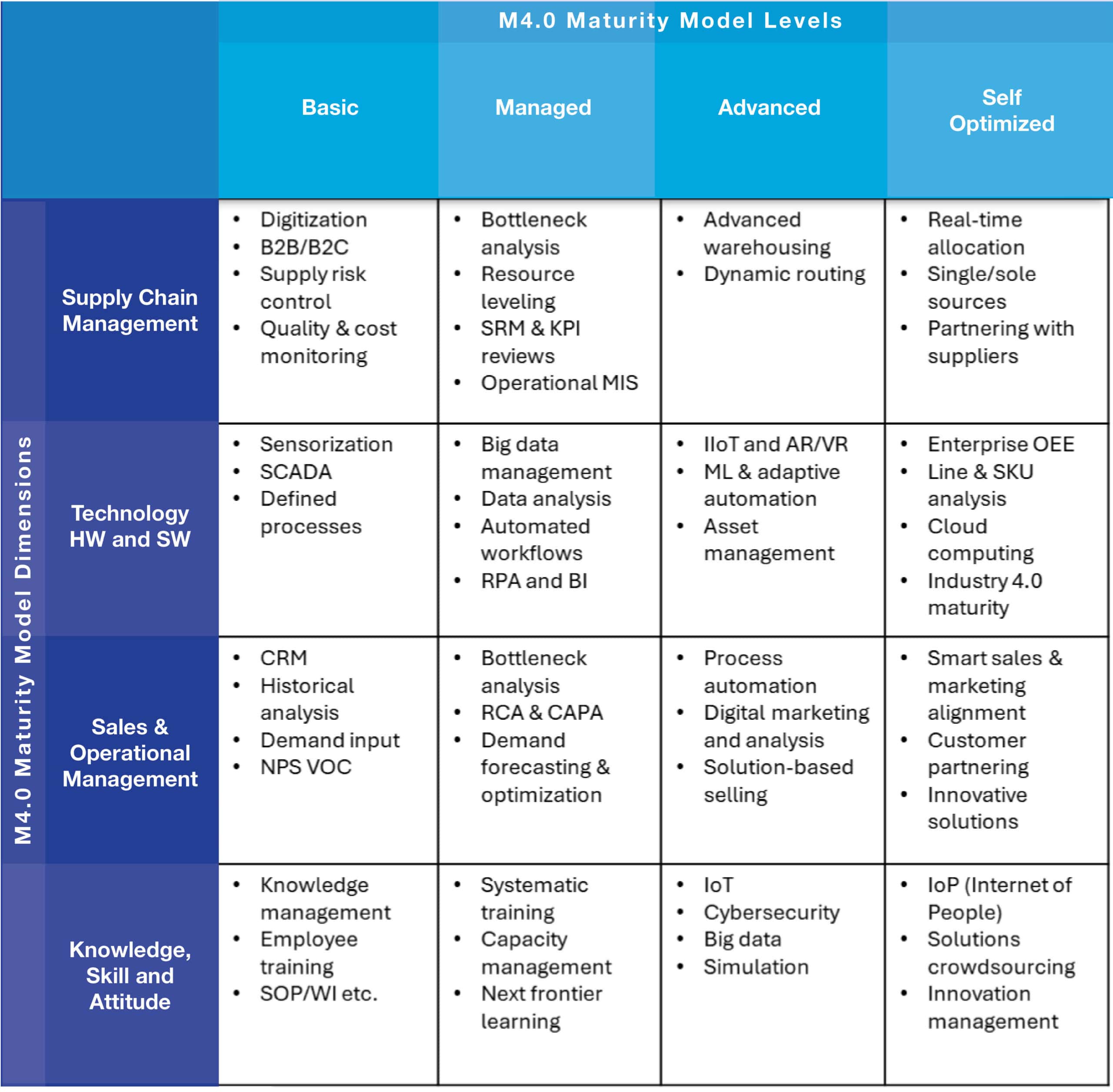
M4.0 Maturity Model FAQs
Q: Is striving to reach the “Self-optimized” level necessary for all companies using the maturity model?
A: While not every company may need to reach the “Self-optimized” level across all dimensions, focusing on key areas where M4.0 technologies can drive significant competitive advantage remains crucial. The implementation of IoT solutions, for instance, allows companies to visualize overall equipment effectiveness (OEE) metrics through easy-to-use dashboards, gain real-time insights into production, and optimize processes. Activities like this can significantly enhance manufacturing efficiency and sustainability, despite being much closer to the “Advanced” level than they are to the “Self-optimized” level.
Q: How does this model, which may seem theoretical, get put into practice?
A: The model primarily serves as a benchmarking tool, allowing companies to compare technology domains across different areas and maturity levels with their current operational state and future goals. This comparison highlights gaps in digital capabilities, illuminating areas ripe for strategic improvement. The real shift from theory to practice occurs when companies begin the phases of adoption, after reaching a consensus on their focus areas and desired technologies. At this point, navigating this transformation involves working with the right partners, adapting management strategies, and ensuring technological integration that goes beyond mere adoption to fully embedding these advancements into the organizational fabric. For more on the practical application of the M4.0 maturity model, see our article “Four Steps to Scale M4.0 Adoption Organization-Wide.”
“Ultimately, it [the model] guides companies through incremental improvements, both in the short and long term, ensuring that enhancements contribute to a unified vision.”
Q: What is the role of plant managers within the model?
A: Plant managers play a crucial role in the digital transformation journey within manufacturing facilities. As digital technologies are increasingly adopted, plant managers emerge as essential leaders of this shift. Their responsibilities extend across several key areas: leading change, integrating data across systems, managing transitions smoothly, and supporting collaboration among teams. As adoption leaders, plant managers ensure their teams are aligned and equipped to excel as the manufacturing technology environment evolves.
Q: Which key performance indicators (KPIs) should a company track when applying the model?
A: Companies should monitor KPIs that align with the model’s four areas, ensuring a holistic view of progress and areas for continuous improvement:
- Supply Chain Management: Focus on KPIs like lead times, inventory turnover rates, supplier performance metrics, and logistics cost to gauge efficiency and responsiveness.
- Technology (Hardware and Software): Track system uptime, response times, frequency of software deployments, and rates of security incidents to evaluate the reliability and efficiency of technological infrastructure and workflows.
- Sales and Operational Management: Measure sales performance, customer satisfaction levels, order fulfillment speeds, and revenue growth to assess the effectiveness of sales strategies and operations.
- Knowledge, Skill, and Attitude: Mature organizations invest in continuous learning and empower employees to contribute effectively. Monitor employee training completion rates, progress in skill development, and employee engagement scores.
Q: How does the model, which categorizes maturity into separate areas and levels, promote organizational integration and visibility?
A: The model, while visually segmented, is designed to promote holistic organizational growth. Its structure allows companies to assess and advance each area systematically without losing sight of overall operational cohesion. By providing clear benchmarks for each area, at each area, at each maturity level, the model enables organizations to see how progress in one segment influences and is influenced by others, fostering end-to-end visibility and integration. Ultimately, it guides companies through incremental improvements, both in the short and long term, ensuring that enhancements contribute to a unified vision.
M4.0 Maturity Model in Action: A Case Study in the Cable Sector
We present a brief case study to demonstrate how the M4.0 Maturity Model works in action.
Challenge
Amidst significant SAP implementations across new plants, our client faced challenges in goal setting and project management due to uneven technology adoption. While advanced systems were deployed in some departments, other areas remained heavily reliant on manual processes, lacking real-time data and streamlined operations. This challenge, a common issue in Latin American markets, hindered operational efficiency and adaptability.
“By leveraging the M4.0 maturity model, companies can unlock manufacturing excellence, enhance operational performance, and secure a competitive advantage within their industry.”
Our Approach
We leveraged a proprietary solution accelerator to integrate IoT sensors with the client’s existing programmable logic controllers and SAP systems and funnel insights into powerful efficiency dashboards. While a more conventional approach would involve developing solutions on one of the main cloud platforms, this often leads to extended project timelines and complex integration processes. Given the client’s concurrent project engagements, they were particularly averse to the risks associated with extensive development and integration phases. By aligning our solution accelerator with the client’s current technological ecosystem, we accelerated adoption timelines while significantly reducing the likelihood of operational disruptions.
Impact
Integrating IoT with the client’s systems propelled them from a basic to an advanced level within the Technology dimension of the M4.0 maturity model in just a few months. This transformation not only showcases the potential for swift operational efficiency improvements using solution accelerators but also highlights the important balance between innovation and execution. By embedding advanced technology within existing infrastructures, this phased approach to adoption bypassed the need for extensive system overhauls.
M4.0 Is a Powerful Framework
The M4.0 maturity model emerges as a powerful framework for navigating the complexities of new technology adoption and process improvement in manufacturing. By offering a structured approach to assess readiness and capabilities across critical dimensions such as supply chain management, technology, sales and operational management, and knowledge, skills, and attitude, the M4.0 model empowers organizations to set realistic goals and embark on a journey of continuous improvement. Through its four maturity levels and comprehensive dimensions, the model serves as a benchmarking tool, guiding companies towards incremental enhancements and fostering a culture of excellence and empowerment. By leveraging the M4.0 maturity model, companies can unlock manufacturing excellence, enhance operational performance, and secure a competitive advantage within their industry. M
About the authors:

Roberto Cisneros is director of IIoT Solution Architecture at Softtek.

Krishnan Venkat is director of Supply Chain Consulting at Softtek.
How Close Is the Smart Factory of the Future?

Manufacturing is marching toward a future that is highly automated, intelligent and flexible.
Increasingly, smart factories are made up of connected machines that generate large amounts of data. This opens the door for artificial intelligence–driven analysis and new opportunities for insights on improving supply chains, processes, the customer experience, product quality and more.
But realizing this transformation can be difficult. Not all manufacturers have the resources, capital or talent required for a smart factory future. How are companies progressing on this journey, and what challenges stand in the way? To find out, the Manufacturing Leadership Council—the NAM’s digital transformation arm—conducted its Smart Factories and Digital Production survey.
Manufacturers are committed to M4.0: When it comes to digital technology, manufacturers are spending at a steady—and in some cases growing—basis.
- Nearly 69% of survey respondents said their M4.0 investments this year would continue unchanged from last year.
- Nearly 19% said they would increase investments, while just 10% said their investments would likely decline.
- Some 58% assessed their company’s digital maturity level in manufacturing operations at three to five on a scale of 10, suggesting the industry has moved beyond the initial stages of M4.0 and has reached an early majority of digital-model adoption.
How widespread are digital factories? Only about 7% of manufacturers say they have digitized their factory operations extensively.
- Approximately 15% expect to have their manufacturing operations digitized end-to-end by 2026.
- About 5% say their factories are already “very smart.”
- Approximately 53% say their factories and plants are getting smarter but are still works in progress.
In the future, will factories run themselves? While some manufacturers foresee a future of “lights out” factories, or those that mostly run themselves, most don’t think they will ever reach that state.
- About 49% of respondents expect fully or partially autonomous factories in the future.
- Some 40% say AI will be either very significant or somewhat significant in the years to come.
- Approximately 56% cite organizational resistance to change as the top barrier to implementing a smart factory.
For more details on these findings and the impact of smart factories as a whole, read the survey report: Smart Factories Are Still a Work in Progress.
What’s Ahead for Manufacturing in 2024?

Getting a solid forecast of the year’s key issues in manufacturing can help your business prepare for anything. A panel of experts recently shared their 2024 outlook in the webinar “What’s Ahead for Manufacturing in 2024?” hosted by the Manufacturing Leadership Council, the NAM’s digital transformation arm.
They offered insights on the 2024 manufacturing economy, legislative climate, digital trends, resilience strategies and more.
Economic outlook: NAM Chief Economist Chad Moutray provided a manufacturing economic update.
Key takeaways:
- The NAM Q4 2023 Manufacturers’ Outlook Survey revealed that more than 66% of member companies have a positive economic outlook for 2024, yet opinions are mixed on whether there will be a recession.
- The top economic challenge this year will be the workforce, with the labor market cooling substantially but remaining tight, Moutray said.
- Private manufacturing construction spending is at an all-time high of $210 billion thanks to the production of semiconductors, electric vehicles and batteries, and general reshoring.
- Risks this year include geopolitical turmoil, slow global economic growth, cost pressures, talk of a recession and labor issues, among others.
Policy perspective: NAM Vice President of Domestic Policy Charles Crain gave an overview of the current climate in Washington, D.C., and the NAM’s legislative priorities.
Key takeaways:
- The NAM will continue its focus on tax policy following House passage of an NAM-supported bipartisan tax package that would reinstate three manufacturing-critical tax provisions.
- Manufacturing is facing a regulatory onslaught, with the average manufacturer paying $29,000 per employee per year due to unbalanced, burdensome regulations, according to a recent NAM-commissioned study.
- Artificial intelligence is a hot topic on Capitol Hill, with 60 AI-related bills introduced in Congress last year. The NAM is working to help policymakers understand the benefits of AI, including safety, worker training, product design and development, and efficiency.
Manufacturing 4.0 Trends: MLC Senior Content Director Penelope Brown offered a look at digital manufacturing trends on the horizon.
Key takeaways:
- Manufacturers can expect to see a broader adoption of existing AI applications, including predictive/preventative maintenance, improved processes and enhanced productivity.
- According to the MLC’s recent Smart Factories and Digital Production survey, 65% of manufacturers anticipate their level of M4.0 investment this year will stay the same as last year.
- Other trends to watch include the rise of global partnerships such as Catena-X and CESMII, digitized supply chains and reshoring.
Resilience perspective: Cooley Group President and CEO (and MLC Board of Governors Chair) Dan Dwight shared his approach to resilience in 2024 and the years to come.
Key takeaways:
- Business leaders should prioritize agility and adaptability, even if it means admitting to suboptimal results that require redirection.
- Resilience doesn’t mean perfection; it means learning from failures.
- AI and machine learning contribute to resilience by building out end-to-end visibility across an organization—from vendors to manufacturing operations to customers.
For additional details from these experts, watch “What’s Ahead for Manufacturing in 2024?”
Connect, Analyze, Improve — Then Rinse and Repeat
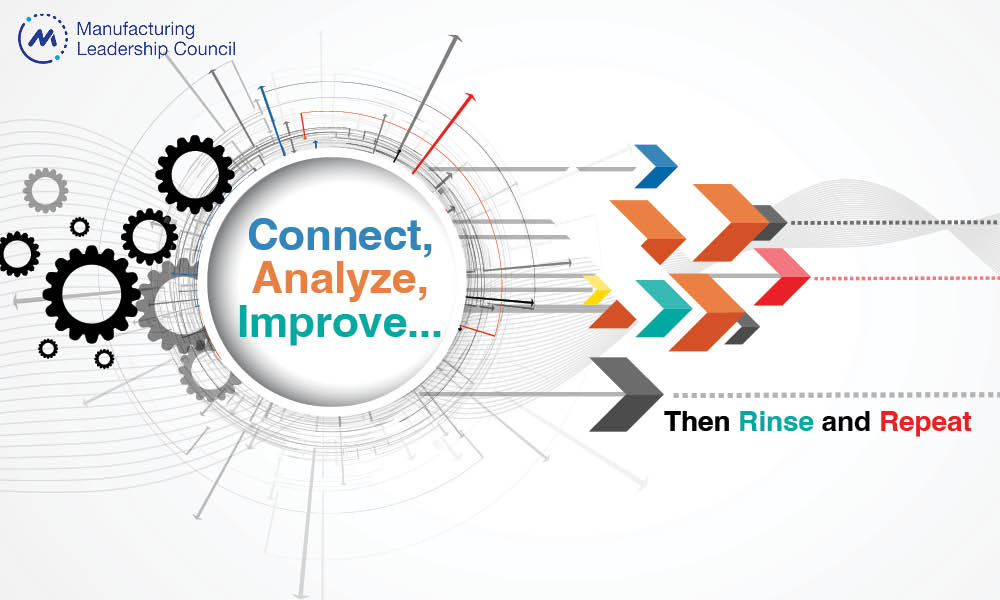
A focus on connecting equipment and then using data to make improvements can create a solid foundation for smart manufacturing.

TAKEAWAYS:
● While manufacturers have embarked on the M4.0 journey and expect it to accelerate, many are still struggling with where to begin.
● A good place to focus is on connecting equipment and then using the data and AI to make improvements in operations.
● As pilot projects build organizational confidence and knowledge, the lessons learned can be applied to other areas of the business.
From conversations at the Manufacturing Leadership Council’s December 2023 Manufacturing in 2030 event, it became clear that the industry is still far from delivering on the vision of Industry 4.0. Although we have been discussing the value of industry 4.0 for over 20 years, companies continue to be challenged on how to drive progress – and for some on even how to get started.
There’s a natural tendency to want to have a cohesive plan or strategy for moving ahead. In the MLC’s recent study, Manufacturers Go All-In on AI, 42% of manufacturing executives cited the lack of comprehensive M4.0 strategy as the top challenge to adopting and using those technologies. Another 37% said the biggest hurdle is their ability to assess the cost/benefit of deployment.
Navigating through the wide array of technologies to develop a M4.0 strategy is challenging. Thinking too broadly can lead to analysis paralysis; thinking too narrowly can make it difficult to demonstrate a level of ROI that warrants investment—especially in the current economic climate.
Cooley Group president and CEO Dan Dwight spoke at the event and offered advice that resonated: “Just get started.”
What does that mean? In our experience working with manufacturing organizations to become digital, making positive strides doesn’t have to be complicated or time-consuming, or even expensive. Find a clear business problem — increasing throughput by improving overall equipment effectiveness or reducing costs by improving quality — that can be solved with better or more timely data from your equipment. Gather data from the equipment involved and analyze that data using a readily available technologies like an industrial AI operating system consisting of an edge platform (data collection), machine learning platform (data analytics), and cloud platform (data management) for a hybrid unified analytics experience. Manufacturers win when they trust their digital partners (system integrators) in deploying these technology solutions in production, at scale.
When done well, this not only solves a problem but also creates a foundation for expanding beyond the pilot and exploring more opportunities to benefit from the technology investment and what your organization has learned.
A Case Study in “Just Get Started”
Our partnership in working for a pet food manufacturer highlights the potential for this approach.
Pet adoptions swelled during the pandemic, accelerating the company’s already rapid growth and challenging its ability to meet demand. Management wanted to increase operational agility to respond better to shifts in demand.
A rapid assessment of operations revealed an opportunity to pilot smart manufacturing technology to better understand what was happening on production lines, including machine availability, to improve efficiency and throughput. We used an industrial automation platform to connect 31 machines across four departments to gather and analyze performance data.

“Thinking too broadly can lead to analysis paralysis; thinking too narrowly can make it difficult to demonstrate a level of ROI that warrants investment.”
This allowed frontline leaders to visualize what machines were doing: Were they up, down, or idle when not expected? Engineers could then look more closely at potential maintenance or other issues. For example, the cumulative production volume would briefly zero out. Further analysis found that trays were getting stuck, thus shutting down the line. Through investigation, we found that operators had performed a hard shutdown of the line to clear the issue, which had negative consequences for the computer equipment. This is a prime example of how root cause analysis, enabled by insight from machine data, helped the company identify and take action for technical, behavioral, and process issues.
The project coupled data insights from the connected equipment with basic management practices to develop new metrics and scorecards, controls, and communication processes across functions and shifts so that employees from management to the shop floor had access to the right data and could use it to optimize operations. Because the machines are connected and delivering real-time data, teams can now see production line status and take action closer to real-time, all without the need for manual data collection.
This solution was simple to set up, allowing us to begin connecting machines within eight weeks. Within 16 weeks, the company was using data to improve its production loss tracking process. The increased throughput translated to an estimated $13 million in incremental capacity, and the project paid for itself within 16 weeks — 10 weeks before it ended. This allowed extra attention to change management to increase knowledge, ownership, and buy-in.
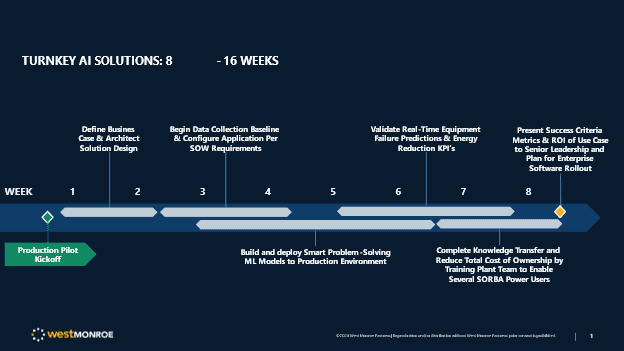
It’s important to reinforce that this was the company’s first foray into smart manufacturing. Four key factors made our efforts successful:
- Identifying a specific and focused business problem and goal for the insight required to address the problem
- Getting buy-in from management to “just get started” as opposed to ongoing debate on the potential value
- Employing available technology to gather the data required
- Using analysis to make operational changes, addressing the people side of change as well as the technology
With this success, the company now had a M4.0 foundation on which it could continue building.
A Case Study in Building on the Foundation
This particular application of M4.0 technology can address multiple operational needs and goals around predictive maintenance, quality control, supply chain optimization, and energy efficiency and sustainability.
In a report for the U.S. Department of Energy, the Lawrence Berkeley National Laboratory studied motor systems in the industrial and commercial building sectors. Among the findings: 75% of industrial motor system electricity consumption is attributed to 1-1500 hp motor systems; however, a lack of sufficient data is a major barrier to capturing energy savings potential in these motor systems. With the increasing pressure on mid-market manufacturers to demonstrate their efforts to curb carbon emissions by their customers, energy monitoring and reduction in manufacturing operations benefits both the top-line and bottom-line.
Starting the journey with a focus on energy efficiency often leads to opportunities to use the same technology to derive benefits in other areas. This has been the case for a Fortune 100 food and beverage company. The organization wanted to reduce fuel waste in high-use assets like compressors and boilers, particularly the steam consumption of wort kettles. In this case, lack of machine data and insights prevented the company from addressing this issue effectively.
The company wanted to pilot a program that allowed real-time AI industrial optimization techniques to improve energy consumption and efficiency, using a platform that would work in different brewery environments. The focus of the pilot project centered around using the SORBA.ai platform to connect the following energy and fluids functions (machine profiles):
- Compressors (ammonia and air) and condensers
- Boilers (biofuel and natural gas), filtration skids, and wort kettles
- Heat exchangers, cooling towers, HVAC equipment, and co-gen turbine engines
The goal for the AI was to optimize performance and improve machine efficiencies, which directly correlates to a reduction in energy consumption. The AI allowed the company to autonomously draw and analyze real-time data to produce insights for optimizing the control of equipment use.
In conjunction, the company equipped 200+ front-line AI users — including developers, engineers, operators, and consultants — with enhanced skills and digital tools to abstract insight, use it to optimize operations, and sustain that performance over time.
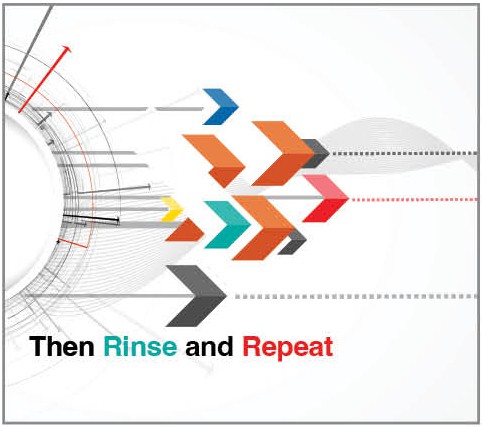
“Starting the journey with a focus on energy efficiency often leads to opportunities to use the same technology to derive benefits in other areas.”
The pilot project reduced fuel and electricity consumption by 5-10%, translating to $100,000 in annual savings per facility/per two use cases—generating a 5x return on investment in less than two years.
More significantly, what started as an energy efficiency project has today grown to include use cases and benefits in other parts of the business:
- Offset of carbon emissions per ton reporting, validated by Department of Energy audits.
- Production capacity increases. By using the same AI technology to optimize control of filtration skids, the company removed capacity constraints, maximizing material flow. As a result, it was able to produce hundreds more barrels of product per specialized membrane filter machine, per production run. This increased production throughput equates to a forecasted gain of $50 million in revenue realized over five years.
- Supply chain optimization. The company reduced technical debt (custom models, rework, data integration) across the supply chain by 33% from raw material (harvested grains) to packaging (bottled and shipped product).
- Quality control. An ancillary benefit of reducing energy through AI process optimization technology helped quality control technicians responsible for the wort kettle process analyze random batch samples and reduce protein coagulation in real-time.
Build the Foundation while Building the Future
Connecting equipment and leveraging machine data is a great way to begin building the foundation for smart manufacturing, and move in the direction of robust strategy around advanced capabilities such as digital twin or simulation. It also helps the organization increase M4.0 maturity, as people learn to use insight and optimize operations.
If you’re struggling with where to focus effort or even where to begin, you aren’t alone. A good way to establish and build momentum is to focus on connecting equipment to gather and use data. Find a use case. Use available technology to connect equipment and gather data. Then analyze the data, learn, apply what you’ve learned, and repeat. As you do, you’ll see the momentum begin to build as the data leads you. M
About the authors:

Randal Kenworthy is Senior Partner, Consumer & Industrial Products at West Monroe

Kris Slozak is Director, Consumer & Industrial Products at West Monroe

AJ Alexander is Managing Director at Sorba.ai
Safeguarding Smart Manufacturing Against Cyberattacks
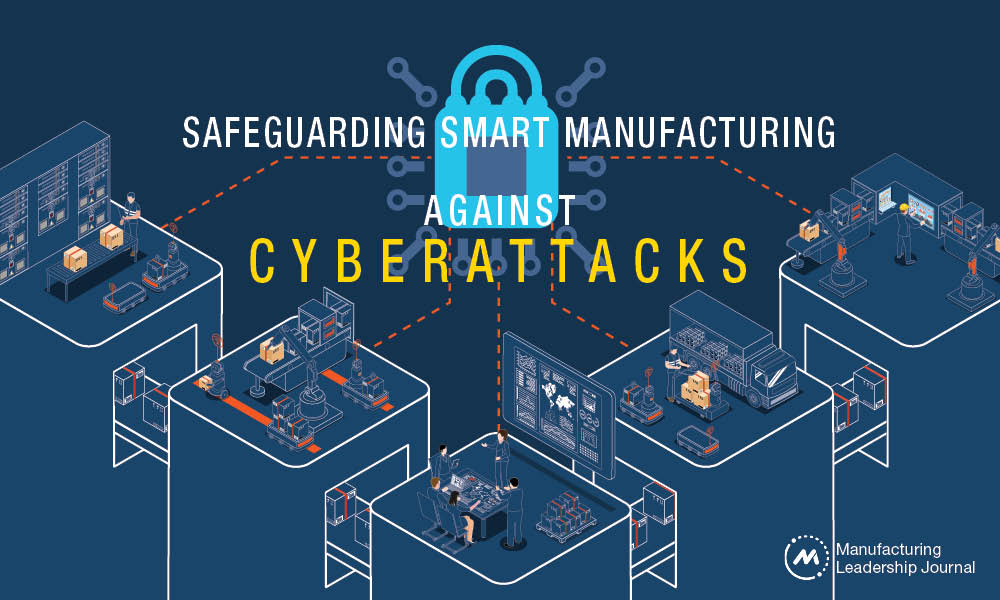
Placing risk management and threat scenario planning at the intersection of smart manufacturing and cybersecurity can fortify organizations.

TAKEAWAYS:
● The arrival of smart manufacturing, driven by AI and advanced technologies, necessitates a paradigm shift in how manufacturers approach cybersecurity.
● Manufacturing systems and facilities are interconnected, making them vulnerable to cyberattacks that can exploit systems at scale.
● Manufacturers can safeguard against cybersecurity threats by leveraging threat scenarios and adopting vigilant but practical risk management practices.
Manufacturers are increasingly leveraging AI-driven or smart manufacturing technologies to enhance their production processes and improve their bottom line. As businesses chart their course for the next five years, data analytics, increased automation, and the adoption of smart manufacturing and cloud technologies are driving forces for growth. Predictive maintenance, quality control, inventory management, supply chain optimization, and autonomous robots are revolutionizing manufacturing by boosting efficiency, quality, and safety. According to the Rockwell State of Smart Manufacturing Survey, most organizations recognize the importance of smart manufacturing, with 45% planning to adopt it within the next year and an additional 39% within 1-2 years. Over 50% more manufacturers are using machine learning and AI technologies than just a year ago, so the transformation is accelerating quickly. In fact, the Manufacturing Leadership Council’s 2023 Transformative Technology survey reveals that 63% of respondents expect Manufacturing 4.0 technology adoption to accelerate in the next two years.
All these transformative technologies share a common requirement: the need for a fortified cybersecurity strategy. Manufacturers must recognize cybersecurity as an integral component of their digital transformation journey. It is not just an afterthought, but rather the first and last question on the journey toward realizing smart manufacturing’s full potential. Establishing a robust cybersecurity strategy involves setting up the right governance structure, integrating technology with people, and focusing on progress over perfection.
The Complexity of Manufacturing Systems
Manufacturing systems are intricately interconnected, making them susceptible to cascading impacts in the event of a cyberattack. As technology evolves, manufacturers are moving from heterogeneous to homogeneous infrastructures, transitioning from purpose-built control system environments with different integrators, OEMs, and profiles to common operating systems, network protocols, and software stacks.
An attack on one system can reverberate through an entire plant, resulting in substantial revenue losses. The similarities between environments also provide an unintended advantage for adversaries – the learning curve is easier, and groups can develop impactful malware at scale.

“An attack on one system can reverberate through an entire plant, resulting in substantial revenue losses.”
The consequences of cyberattacks on manufacturing operations can be far-reaching and detrimental, affecting key components for operations, productivity, and safety. Depending on the malware functions and attack intentions, attacks can target manufacturing operations by affecting any of the three main systems of a plant:
- Manufacturing Execution Systems (MES): MES systems play a pivotal role in data interchange between business and operations, making them prime targets for cyberattacks.
- Plant Floor Assets: Assets like Human Machine Interfaces (HMIs) and controllers are indispensable for controlling equipment and processes. Disruption of these systems can bring manufacturing production to a standstill.
- Enterprise Resource Management (ERP): ERP systems, centralizing plant data, downtimes, and production constraints, are crucial to the manufacturing industry’s corporate side.
These interdependencies underscore the importance of threat scenarios as essential components of cybersecurity planning for operational technology environments.
Threat scenarios simplify the process of risk assessment by identifying and prioritizing vulnerabilities that hold the utmost relevance in your specific environment, thus aiding in the allocation of resources. Simulated threat scenarios serve as litmus tests for assessing your level of preparedness, enabling manufacturers to pinpoint security control gaps effectively. By using realistic scenarios, you can strategically engineer your architectures to defend against the most probable Tactics, Techniques, and Procedures (TTPs).
Threat scenario analysis concentrates the deployment of security controls on those areas with the highest risks, fostering proactive defense measures. These scenarios enhance incident response planning, facilitating the development of effective strategies, role definitions, and containment and recovery procedures. Well-understood threat scenarios unite different teams across your enterprise, and you can rally around them to promote a continuous improvement culture through regular employee training.

“The consequences of cyberattacks on manufacturing operations can be far-reaching and detrimental for operations, productivity and safety.”
Step-by-Step Guidance for Using Threat Scenarios to Improve Your Cybersecurity Program
Step 1: Choose Threat Scenarios: Select three to four threat scenarios that resonate most with your sub-sector and environment. These will be the focal points of your cybersecurity strategy.
Dragos recommends starting with these four common scenarios for manufacturing environments:
- Ransomware: Ransomware attacks are a significant concern, with their initial access stemming from various sources such as remote connections or leveraging information technologies/operational technologies (IT/OT) dependencies. These attacks involve exfiltrating information, encrypting files, and locking compromised computing systems, demanding ransom payments for their release.
- Trusted Vendor Compromise: Trusted vendors may unwittingly become conduits for cyberattacks when their software becomes compromised before distribution. These attacks can disrupt the supply chain.
- Shared IT/OT Dependencies: OT systems’ reliance on IT systems or insecure remote access into OT environments can result in IT compromises affecting OT, potentially causing disruptions.
- PIPEDREAM: PIPEDREAM is a highly scalable industrial malware that targets industrial control systems. While it was detected and analyzed in 2022, it remains a potential threat, underlining the need for preparedness.
Step 2: Identify Crown Jewels: Identify the critical assets within your environment — typically constituting about 25% of your infrastructure — and prioritize their protection.
Step 3: Align Around the SANS Five Critical Controls: Dragos and the SANS Institute undertook extensive research to discern the most effective measures to counter incidents within Industrial Control System (ICS) environments. These efforts resulted in the formulation of the SANS Five Critical Controls, a concise framework that outlines essential steps manufacturers must take to establish a robust security strategy against genuine threats.

“Threat scenarios simplify the process of risk assessment by identifying and prioritizing vulnerabilities that hold the utmost relevance.”
The SANS Five Critical Controls include:
- Incident Response: To effectively address cybersecurity incidents, it is imperative to envision and plan for the worst-case scenarios. What does a “bad day” look like, and how should your security program respond to such scenarios? Focus on scenarios that hold real relevance to your specific industry and environment, avoiding theoretical exercises in favor of real-life, industry-specific threats. Get a thorough understanding of the risks involved by meticulously examining each scenario from inception to resolution. Select three to four scenarios, like the ones listed above, and reverse-engineer strategies for handling them effectively.
- Defensible Architecture: A well-designed and segmented architecture forms the bedrock of a defensible cybersecurity strategy. It should empower human defenders to thwart human adversaries effectively. Consider whether your architecture can support the collection of critical data needed for incident response. While IT predominantly deals with data and systems, OT encompasses systems of systems and physics. Failing to account for the transient nature of data in OT can be detrimental during investigations and incident recovery.
- Visibility and Monitoring: Achieving comprehensive visibility across your network is indispensable. It involves monitoring control system protocols and communications within your processes, reinforcing the foundation of a defensible architecture. Operational resilience hinges on the ability to conduct root cause analysis, enabling the detection of threats and understanding the scenarios most likely to impact your environment. This should align with your organization’s unique priorities.
- Secure Remote Access: Secure remote access demands multifactor authentication and meticulous supply chain management. Interconnectedness exposes your risk to the risks of others, emphasizing the need for a robust approach to remote access.
- Vulnerability Management: Effective vulnerability management is not about indiscriminate patching but focuses on the vital 2-4% of vulnerabilities that truly matter. Identifying these vulnerabilities and knowing how to address them is essential.
In concert, these five critical controls constitute the foundation of a potent cybersecurity program and give you something to measure against.
Step 4: Conduct a Risk Assessment: Assess the current state of your environment to understand existing vulnerabilities and potential risks.
Step 5: Identify Gaps and Priorities: Based on your risk assessment, identify gaps in your cybersecurity defenses and establish priorities for mitigating them. This step forms the basis for your cybersecurity roadmap.
The Bottom Line: Adopt a Vigilant – But Practical – Risk Management Strategy
The advent of smart manufacturing, driven by AI and advanced technologies, necessitates a paradigm shift in how manufacturers approach cybersecurity. It must be an integral and proactive component of your digital transformation journey. By leveraging threat scenarios and adopting a vigilant but practical stance toward risk management, manufacturers can safeguard their operations, protect sensitive data, and position themselves for success in an evolving landscape where innovation and security must go hand in hand. M
About the Author:

Michael Sakmar is the Vice President of Professional Services at Dragos, Inc., where he leads teams of consultants in performing active defense inside of ICS/OT environments. He is responsible for a range of services such as architecture assessments, penetration testing, tabletop exercises, and incident response.